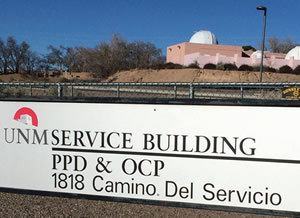University of New Mexico
Project Snapshot
PROJECT: Sustainable Solutions for College Maintenance and Management
INSTITUTION: University of New Mexico
LOCATION: Albuquerque, NM
COMPANY NAME: Air Cycle Corporation
WEBSITE: www.AirCycle.com

UNM will save valuable storage space and save on recycling costs by using the Bulb Eater 3, from Air Cycle.
PROJECT DESCRIPTION
The University of New Mexico (UNM) is a nationally recognized leader in higher education that prides itself in the use of sustainable practices to ensure a positive impact on the environment. As part of this commitment, UNM had looked for a safe and economical way to handle fluorescent lamp waste. Since these lamps contain mercury, proper management and disposal is regulated by the EPA, the sending of spent lamps to a local landfill was not an option.
THE CHALLENGE
Managing proper handling and disposal of intact lamps require a large amount of time and storage. Additionally, lamps are made of glass, which presents potential breakage during handling and storage. As a large campus, UNM also faced challenges associated with generating lamps of all shapes and sizes along with unexpected costs due to the required recycling of spent lamps.
“The UNM needs a safe and economical way to dispose of fluorescent lamps that requires less time, labor, storage space and reduces cost for proper disposal,” says Scott George, supervisor of recycling at UNM.
THE SOLUTION
A few different solutions exist for proper disposal of lamp waste depending on the size of the college. Facilities over 200,000 square feet highly benefit from using a drum-top lamp crushing system such as the Bulb Eater 3 (BE3). The new design of the system has advanced safety features for personnel and allows for any type of fluorescent lamp, including straight lamps, U-bends and CFLs in the same machine.
This solution is far more efficient and will eliminate the unnecessary time it takes to pack and store spent lamps for proper disposal. UNM will save valuable storage space and save on recycling costs. What previously was stored on a four-foot-by-four-foot-by-six-foot pallet can now be contained in one 55-gallon drum. The BE3 machine eliminates accidental breakage from storing boxes of lamps and prevents release of mercury vapor into the environment.
IMPACT ON LEARNING
UNM was able to take ownership of universal waste issues with respect to mercury-containing lamps, as well as play a significant role in responsible waste disposal through the use of Air Cycle’s BE3 lamp crushing machine.
“We would recommend that any facility handling fluorescent bulbs consider the many advantages that the BE3 can provide including convenience, time and labor savings, and especially the environmental aspects of keeping mercury waste out of the local landfill. We save thousands of dollars per year using Air Cycle’s sustainable services and technology,” concludes George.
Editor’s Review
Regulations have been established by the U.S. EPA to reduce the release of mercury into the environment and to encourage proper recycling. Protecting the health and safety of students through proper and documented recycling programs reduces the liability of your institution. Plus, students like to see that their university has a commitment to the environment. A bulb/lamp recycling program such as the one put in place at the UNM contributes not only to the health and satisfaction of students, leading to better academic results, but also to the university’s standing, security and the bottom line.
This article originally appeared in the issue of .